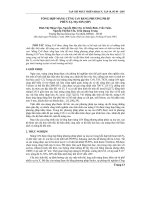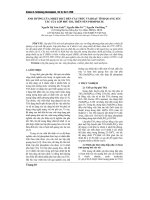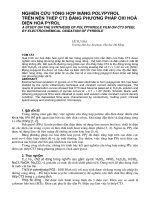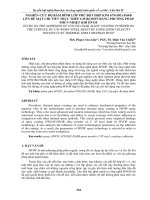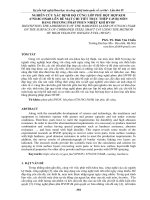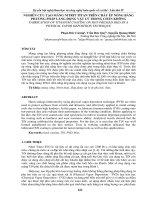Lắng đọng lớp phủ CrN trên nền thép SKD61 bằng phương pháp phún xạ xung một chiều magnetron
Bạn đang xem bản rút gọn của tài liệu. Xem và tải ngay bản đầy đủ của tài liệu tại đây (3.98 MB, 5 trang )
058-062
1,2*,
1,3
1
4
1
2
q
K
C6 -6-
3
4
,
,
-02-2017
B
trên thi
thiên áp -150 V.
B30 VTD
320 W,
2 trong
m.
2
là 6 sccm,
- 4,11 GPa
và
nén
.
Abstract
This paper discussed about the CrN layer coating on SKD61 substrate with pulse DC magnetron sputtering
by B30-VTD equipment. The vacuum system has power pulses, kept at capacity of 320 W and bias voltage 150 V on the substrate. The N2 gas flow is controled in range 4 ÷ 8 sccm and pulse frequency varied in
range 150 ÷ 50 kHz. The experiment results demonstracted the deposition rate of CrN layer was affected by
N2 gas flow and pulse frequency. The coating thickness decreased with increasing gas flow and pulse
frequency from 7.1 down to 4.2 m. The X-ray diffraction (XRD) of CrN coating was shown that the layer has
good stabilization with crystalline structure in N 2 gas flow 6 sccm, the main crystal orientation [200], the
maximum residual compressive stress under the surface (200) was - 4.11 GPa in case of frequency pulse
150 kHz.
Keywords: Pulsed DC sputtering; CrN coating; Pressure molding; Residual stress.
*
0
0
*
058-062
2.
-1
2.
-2
f
0
0 -1
058-062
f
2
0
2
2
2
2
2
3.
2
2
2
1
x
1
2
2
x
2
x
CrN
CrN
CrN
CrN
CrN
Cr2N
CrN
CrN
Cr
2
2
2
2
058-062
2
2
2
2
2
Ar
N2
0
2
2
2
2
2
2
2
2
[1]
Failure Analysis 20 (2012) 43-53.
[2]
between molten aluminum and selected die castings
2
2
/>Manager/digitool_items/csm01_storage/2013/09/03/fi
le_1/212644.
[3]
P.J.C. Avelar-Batista
thickness and deposition methods on the stripping
rate of CrTechnology 200 (2005) 1842-1848.
[4]
O. Salas, K. Kearns, S. Carrera, J.J. Moore
058-062
[12]
172 (2003) 117-127.
[5]
Eduardo K. Tentardini, Augusto O. Kunrath, Cesar
Aguzzoli, Maria Castro, John J. Moore, Israel J.R.
and Residual Str
(2011) 929-940.
Materials 4
[13]
(2007).
Coatings Technology, 202 (2008) 3764-3771.
[6]
J. Lin, S. Carrera, A.O. Kunrath, D. Zhong, S. Myers,
for optimized die coatings: The case for aluminum
pressure dieTechnology, 201 (2006) 2930-2941.
[7]
ardness and adhesion
properties of CrN films deposited on nitrided and
Coatings Technology 88 (1996) 183-189.
[8]
Lugscheider, K. Bobzin, Th. Hornig, M. Maes
l
properties of (Cr,Al)N arc PVD coatings used for
semiFilms 420-421 (2002) 318-323.
[9]
M. Gelfi, G.M. La Vecchia, N. Lecis, S. Troglio
-thickness residual
stress of CrN-PVDcoatings and fatigue nucleation
263-268.
[10] V.D. Ovcharenko, A.S. Kuprin, G.N. Tolmachova
Plasma Physics (20) 204-207.
[11] V.D. Ovcharenko, A.S. Kuprin, G.N. Tolmachova,
coatings using vacuum arc plasma in increased
27-34.
[14] J. Lin, Z.L. Wu, X.H. Zhang
CrNx coatings Synthesized by dc and pulsed dc
Thin Solid Films 517 (2009)
1887-1894.
[15]
structure and properties of chromium nitride coatings
deposited using dc, pulsed dc and modulated pulse
,Surface
and
CoatingsTechnology 204 (2010) 2230-2239.
[16] Jyh-Wei Lee, Shih-Kang Tien, YuEffects of Substrate Bias, Substrate Temperature, and
Pulse Frequency on the Microstructures of Chromium
Nitride Coatings Deposited by Pulsed Direct Current
ournal of
Electronic materials, Vol. 34, No. 12(2005) 14841492.
[17] Jianliang Lin, William D. Sproul, John J. Moore
2N coatings
using modulated pulse power (MPP) magnetron
, Surface & Coatings Technology 205
(2011) 3226-3234.
[18] A.P. Ehiasarian, W.power pulsed magnetron sputtered CrNx
Surface and Coatings Technology 163-164 (2003)
267-272.
[19] Jyh-Wei Lee, Shihproperties evaluation of the CrN coatings deposited
,
Surface & Coatings Technology 200 (2006) 33303335.
